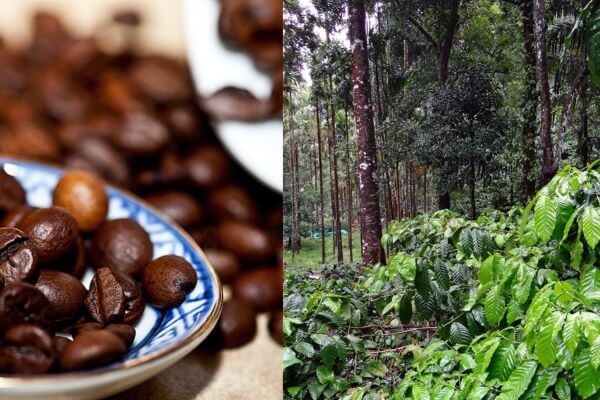Robusta coffee, known for its bold flavor and higher caffeine content, has gained significant popularity among coffee enthusiasts. While Arabica coffee often takes the spotlight, Robusta deserves its own recognition for its unique characteristics and contributions to the coffee world.
In this article, we will delve into the richness of Robusta coffee, exploring its distinctive features, the benefits it offers, and some of the popular blends that incorporate this robust variety.
Robusta coffee (Coffea canephora) originated in the western and central regions of sub-Saharan Africa, thriving in environments with lower altitudes and warmer climates compared to its counterpart, Arabica. The robusta plants are more resistant to pests and diseases, making them easier to cultivate.
Today, Robusta is widely grown in various parts of the world, including Southeast Asia, Brazil, and parts of Africa.
One of the key characteristics of Robusta coffee is its bold and intense flavor profile. It is known for its earthy, woody, and sometimes even nutty notes. Robusta tends to have a higher bitterness and a fuller body, making it a preferred choice for those who enjoy a strong and powerful cup of coffee.
The higher caffeine content in Robusta also contributes to its invigorating effect, providing an energizing boost to coffee drinkers.
Despite its robust nature, Robusta coffee offers several benefits worth exploring. The higher caffeine content can provide a more immediate and pronounced stimulating effect, making it an ideal choice for those who need a quick pick-me-up in the morning or during a busy day.
Additionally, Robusta coffee is often more affordable compared to Arabica, making it accessible to a wider range of consumers.
In terms of popular blends, Robusta is often used as a key component in espresso blends. Its strong flavor and higher caffeine content help to create a rich and bold espresso shot that forms the foundation for many coffee-based beverages like cappuccinos and lattes.
The addition of Robusta adds depth and intensity to the overall flavor profile of these blends, providing a satisfying and robust coffee experience.
As with any type of coffee, the quality of Robusta beans and their processing methods play a crucial role in the final taste and aroma. When selecting Robusta coffee, it is important to choose beans that have been carefully harvested and processed to maintain their unique characteristics.
Look for reputable coffee brands and roasters that prioritize quality and sustainability in their sourcing practices.
In the next sections, we will further explore the world of Robusta coffee, delving into its cultivation methods, processing techniques, brewing recommendations, and some of the popular blends that showcase its boldness and distinct flavors. So, grab your favorite mug and get ready to embark on a flavorful journey into the world of Robusta coffee!
Stay tuned for the upcoming sections where we will uncover the secrets behind the cultivation and processing of Robusta coffee, as well as provide brewing tips and insights into some of the popular blends that make use of its boldness and unique flavors.
The Robusta Coffee Cultivation: Thriving in Challenging Environments
Robusta coffee, scientifically known as Coffea canephora, is a species of coffee that is highly esteemed for its ability to thrive in challenging environments. Unlike its counterpart Arabica coffee, Robusta is known for its resilience, adaptability, and remarkable ability to withstand harsh conditions, making it an important coffee variety in the global coffee industry.
Origins and Geographic Distribution
Robusta coffee originated in Central and Western Africa, specifically in the regions of Congo, Uganda, and Angola. It is believed to have been first discovered in the late 19th century. The species gained recognition for its unique characteristics and suitability for cultivation in regions where Arabica coffee struggled to grow.
Today, Robusta coffee is grown across the globe, with significant production in countries such as Vietnam, Brazil, Indonesia, and Ivory Coast. These regions provide the ideal conditions for Robusta cultivation, including lower elevations, warmer temperatures, and higher rainfall, which are often unsuitable for Arabica coffee.
Resilience and Adaptability
One of the key factors that sets Robusta coffee apart is its resilience in challenging environments. It has evolved to thrive in regions with lower altitudes, where Arabica coffee struggles due to its susceptibility to diseases, pests, and temperature variations.
Robusta plants have a higher resistance to diseases such as coffee leaf rust and withstand higher temperatures, making them a viable option for coffee farmers in these regions.
Additionally, Robusta coffee is known for its adaptability to different soil types, including sandy and acidic soils. This adaptability allows for cultivation in diverse agricultural landscapes, expanding the reach of coffee production to areas that may not be suitable for other coffee varieties.
Flavor Profile
Robusta coffee is characterized by a bolder and more robust flavor profile compared to Arabica coffee. It typically exhibits earthy, woody, and nutty notes, along with a higher level of bitterness and astringency. The higher caffeine content in Robusta coffee contributes to its distinctive flavor and energizing qualities.
Although Robusta is often associated with lower-quality coffee, the specialty coffee industry has seen a rise in the appreciation for its unique characteristics. When grown and processed with care, Robusta coffee can exhibit nuanced flavors and contribute to complex blends, offering a different experience for coffee enthusiasts.
Challenges and Advancements in Robusta Cultivation
While Robusta coffee has its advantages, it also faces its share of challenges. Climate change, pests, and diseases pose significant threats to Robusta crops, impacting yields and overall production. However, ongoing research and advancements in cultivation techniques are aimed at mitigating these challenges and ensuring the sustainability of Robusta coffee farming.
Agroforestry practices, such as shade-grown farming, have gained attention in Robusta cultivation. By planting shade trees alongside coffee plants, farmers can create a microclimate that provides protection from excessive sunlight and temperature fluctuations, reducing the risk of crop damage and enhancing soil health.
Additionally, genetic research and breeding programs are focused on developing disease-resistant and high-yielding Robusta coffee varieties. These advancements aim to improve the quality and productivity of Robusta crops, ensuring a sustainable supply of this resilient coffee variety.
The Importance of Robusta Coffee
Robusta coffee plays a crucial role in the global coffee industry. Its ability to thrive in challenging environments and produce higher yields makes it a valuable commodity for coffee farmers, particularly in regions where Arabica cultivation may not be feasible.
The economic significance of Robusta coffee cannot be overstated, as it provides livelihoods for many coffee-producing communities worldwide.
Furthermore, Robusta coffee serves as an essential component in blends, adding body, crema, and a distinctive flavor profile to espresso-based beverages. Its higher caffeine content also contributes to the sought-after “kick” in espresso shots, appealing to coffee drinkers who desire a stronger and more energizing cup of coffee.
In recent years, there has been a growing appreciation for specialty Robusta coffee, with specialty coffee roasters and enthusiasts recognizing its potential for unique flavor experiences. This newfound interest has led to increased investments in improving the quality and sustainability of Robusta cultivation, paving the way for a more diverse and exciting coffee landscape.
Robusta coffee is a remarkable coffee variety that thrives in challenging environments, offering unique flavor profiles, adaptability, and resilience. Its cultivation provides economic opportunities for coffee-growing regions worldwide, contributing to the rich tapestry of the global coffee industry.
As coffee lovers, let’s embrace the diversity of coffee and celebrate the distinctiveness of Robusta. From its origins in Africa to its widespread cultivation today, Robusta coffee stands as a testament to the perseverance and ingenuity of coffee farmers.
So, the next time you enjoy a cup of coffee with bold flavors and a robust kick, remember the story behind the beans and appreciate the journey they’ve taken to reach your mug.
From Bean to Brew: Processing Robusta Coffee
The processing methods used for Robusta coffee can significantly impact its flavor and quality. In this section, we will uncover the different processing techniques employed for Robusta beans, including the dry and wet processing methods, and their influence on the final cup.
Brewing Boldness: Techniques for Robusta Coffee
Robusta coffee requires specific brewing techniques to bring out its bold flavors and unique characteristics. This section will provide brewing recommendations for Robusta coffee, including the ideal water temperature, grind size, and brewing methods that enhance its robustness and intensity.
Robusta Blends: Exploring Flavor Combinations
Robusta coffee is often blended with other coffee varieties to create unique flavor profiles. This section will delve into some popular Robusta blends, such as the classic Italian espresso blend and the bold and earthy French roast blend, showcasing the diverse range of flavor combinations that incorporate Robusta.
Robusta Coffee’s Health Benefits: More than Boldness
While known for its boldness, Robusta coffee also offers several health benefits. In this section, we will explore the potential health advantages of consuming Robusta coffee, including its higher antioxidant content and potential effects on metabolism and mental alertness.
Sustainable Robusta Coffee Farming: Environmental and Social Considerations
Sustainability in coffee farming is of utmost importance. This section will shed light on sustainable practices in Robusta coffee cultivation, such as shade-grown farming, fair trade initiatives, and efforts to reduce the environmental impact of coffee production.
Robusta Coffee and Culinary Delights: Beyond the Brew
Robusta coffee can be a versatile ingredient in culinary creations. In this section, we will explore how Robusta coffee is used in various culinary applications, including desserts, sauces, and marinades, adding depth and richness to a wide array of dishes.
Robusta Coffee’s Cultural Significance: From Traditions to Rituals
Coffee holds a special place in many cultures, and Robusta coffee is no exception. This section will highlight the cultural significance of Robusta coffee in different regions, including its role in traditional ceremonies, social gatherings, and daily rituals.
The Rise of Specialty Robusta Coffee: Redefining Perceptions
Traditionally, Robusta coffee has been perceived as a lower-quality coffee variety. However, the specialty coffee movement is challenging this perception. This section will explore the emergence of specialty Robusta coffee, where growers focus on producing high-quality beans with exceptional flavors.
Robusta Coffee and Beyond: Exploring New Frontiers
Robusta coffee, scientifically known as Coffea canephora, is a species of coffee that is highly esteemed for its ability to thrive in challenging environments. Unlike its counterpart Arabica coffee, Robusta is known for its resilience, adaptability, and remarkable ability to withstand harsh conditions, making it an important coffee variety in the global coffee industry.
Origins and Geographic Distribution
Robusta coffee originated in Central and Western Africa, specifically in the regions of Congo, Uganda, and Angola. It is believed to have been first discovered in the late 19th century. The species gained recognition for its unique characteristics and suitability for cultivation in regions where Arabica coffee struggled to grow.
Today, Robusta coffee is grown across the globe, with significant production in countries such as Vietnam, Brazil, Indonesia, and Ivory Coast. These regions provide the ideal conditions for Robusta cultivation, including lower elevations, warmer temperatures, and higher rainfall, which are often unsuitable for Arabica coffee.
Resilience and Adaptability
One of the key factors that sets Robusta coffee apart is its resilience in challenging environments. It has evolved to thrive in regions with lower altitudes, where Arabica coffee struggles due to its susceptibility to diseases, pests, and temperature variations.
Robusta plants have a higher resistance to diseases such as coffee leaf rust and withstand higher temperatures, making them a viable option for coffee farmers in these regions.
Additionally, Robusta coffee is known for its adaptability to different soil types, including sandy and acidic soils. This adaptability allows for cultivation in diverse agricultural landscapes, expanding the reach of coffee production to areas that may not be suitable for other coffee varieties.
Flavor Profile
Robusta coffee is characterized by a bolder and more robust flavor profile compared to Arabica coffee. It typically exhibits earthy, woody, and nutty notes, along with a higher level of bitterness and astringency. The higher caffeine content in Robusta coffee contributes to its distinctive flavor and energizing qualities.
Although Robusta is often associated with lower-quality coffee, the specialty coffee industry has seen a rise in the appreciation for its unique characteristics. When grown and processed with care, Robusta coffee can exhibit nuanced flavors and contribute to complex blends, offering a different experience for coffee enthusiasts.
Challenges and Advancements in Robusta Cultivation
While Robusta coffee has its advantages, it also faces its share of challenges. Climate change, pests, and diseases pose significant threats to Robusta crops, impacting yields and overall production. However, ongoing research and advancements in cultivation techniques are aimed at mitigating these challenges and ensuring the sustainability of Robusta coffee farming.
Agroforestry practices, such as shade-grown farming, have gained attention in Robusta cultivation. By planting shade trees alongside coffee plants, farmers can create a microclimate that provides protection from excessive sunlight and temperature fluctuations, reducing the risk of crop damage and enhancing soil health.
Additionally, genetic research and breeding programs are focused on developing disease-resistant and high-yielding Robusta coffee varieties. These advancements aim to improve the quality and productivity of Robusta crops, ensuring a sustainable supply of this resilient coffee variety.
The Importance of Robusta Coffee
Robusta coffee plays a crucial role in the global coffee industry. Its ability to thrive in challenging environments and produce higher yields makes it a valuable commodity for coffee farmers, particularly in regions where Arabica cultivation may not be feasible. The economic significance of Robusta coffee cannot be overstated, as it provides livelihoods for many coffee-producing communities worldwide.
Furthermore, Robusta coffee serves as an essential component in blends, adding body, crema, and a distinctive flavor profile to espresso-based beverages. Its higher caffeine content also contributes to the sought-after “kick” in espresso shots, appealing to coffee drinkers who desire a stronger and more energizing cup of coffee.
In recent years, there has been a growing appreciation for specialty Robusta coffee, with specialty coffee roasters and enthusiasts recognizing its potential for unique flavor experiences. This newfound interest has led to increased investments in improving the quality and sustainability of Robusta cultivation, paving the way for a more diverse and exciting coffee landscape.
Robusta coffee is a remarkable coffee variety that thrives in challenging environments, offering unique flavor profiles, adaptability, and resilience. Its cultivation provides economic opportunities for coffee-growing regions worldwide, contributing to the rich tapestry of the global coffee industry.
As coffee lovers, let’s embrace the diversity of coffee and celebrate the distinctiveness of Robusta. From its origins in Africa to its widespread cultivation today, Robusta coffee stands as a testament to the perseverance and ingenuity of coffee farmers.
In conclusion
So, the next time you enjoy a cup of coffee with bold flavors and a robust kick, remember the story behind the beans and appreciate the journey they’ve taken to reach your mug.
Robusta coffee stands proudly as a bold and resilient coffee variety, offering a distinctive flavor profile and numerous possibilities for coffee lovers. From its origins in challenging environments to its role in creating rich blends and culinary delights, Robusta coffee has carved a unique place in the coffee world.
While often overshadowed by Arabica coffee, Robusta’s boldness and higher caffeine content make it a preferred choice for those seeking a robust and energizing coffee experience. Its earthy, woody flavors and fuller body provide a distinct sensory adventure, complementing a variety of brewing methods and blending opportunities.
Furthermore, Robusta coffee has its own set of health benefits, with higher antioxidant levels and potential effects on metabolism and mental alertness. It is also crucial to support sustainable Robusta farming practices that prioritize environmental preservation and social well-being.
As the specialty coffee movement gains momentum, we witness the emergence of specialty Robusta coffee, challenging conventional notions and elevating the status of this unique variety. With increased focus on quality cultivation, processing techniques, and innovative brewing methods, Robusta coffee is finding its place among coffee connoisseurs and enthusiasts worldwide.
So, whether you’re a fan of the boldness, intrigued by its versatility in culinary applications, or simply seeking a powerful caffeine kick, Robusta coffee has something to offer. Embrace the richness of Robusta, explore its origins, experiment with blends and brewing methods, and savor the delightful flavors that this underrated coffee variety brings to your cup.
In this article, we’ve only scratched the surface of the world of Robusta coffee. Its potential is vast, and its story continues to unfold with each sip. So, join us in celebrating the boldness of Robusta coffee and embark on a flavorful journey that goes beyond the ordinary.
Cheers to the richness, vibrancy, and endless possibilities of Robusta coffee!
Remember to stay tuned for more exciting coffee-related articles and explore the captivating world of this beloved beverage.



